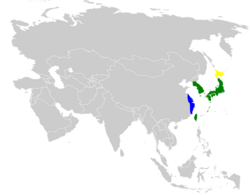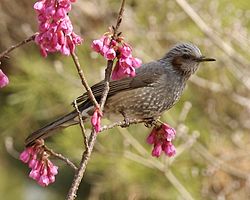| Brown-eared bulbul | |
|---|---|
 | |
| Osaka | |
| Scientific classification | |
| Kingdom: | Animalia |
| Phylum: | Chordata |
| Class: | Aves |
| Order: | Passeriformes |
| Family: | Pycnonotidae |
| Genus: | Hypsipetes |
| Species: | H. amaurotis |
| Binomial name | |
| Hypsipetes amaurotis (Temminck, 1830) | |
 | |
| Distribution map breeding area resident wintering area | |
| Synonyms | |
| |
The brown-eared bulbul (Hypsipetes amaurotis) is a medium-sized bulbul native to eastern Asia. It is extremely common within the northern parts of its range and can be found from southern Sakhalin to the northern Philippines.
Contents
- Taxonomy and systematics
- Subspecies
- Description
- Distribution and habitat
- Behaviour
- Breeding
- Feeding
- Diseases
- References
- Further reading
- External links



